This Is Why Stone Retaining Walls Fail, How We Repair Stone Retaining Walls For Our Clients In Kansas City, Missouri, And How Long Retaining Walls Last
It’s smart to know the lifespan of your retaining walls. Even though they’re made from stone, they can’t last forever.
In this post, you can find out why retaining walls fail. You can also discover how to fix a leaning stone retaining wall and how to repair a collapsed stone retaining wall. Finally, you can find out how long should a retaining wall last (which should be a long time, depending on your Kansas City, MI, stone retaining wall landscaper.

Does Our Retaining Wall Look…Off?
“Jenn, come take a look at this!” yells Michael from the front door.
“Ok,” she answers, standing up from the couch. Michael walks her to the driveway and points beside the driveway. “Does our retaining wall look…off, to you?” he asks.
Jennifer stares at it, turning her head a few times, walking around to get different angles. “I’m not too sure. Shouldn’t it still be ok for a lot longer?
Michael shrugs. “Unless it wasn’t built well then yeah. I’m going to still look up how to fix a leaning stone retaining wall, how to repair a collapsed stone retaining wall, and how long should a retaining wall last.”
Jennifer nods. “Then I’ll look into stone retaining wall installers near us, just in case.” Michael nods and the couple starts digging around Google.
Here’s what Michael finds:
7 Reasons Why Retaining Walls Fail
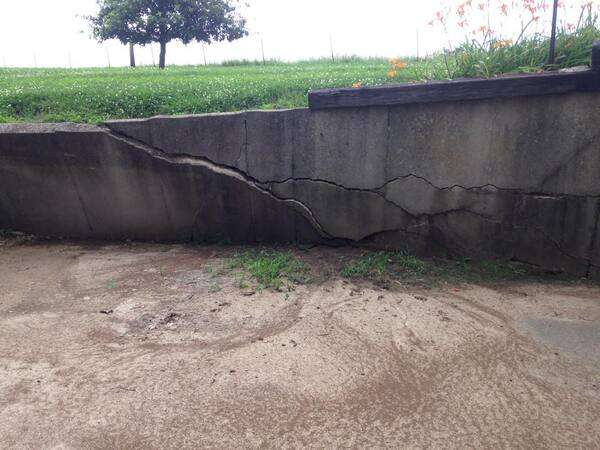
Retaining walls fail when they can’t hold back the weight of the dirt behind them. This can happen because the retaining wall was built poorly. It can also be due to the combined weight of the soil and the water causing damage over time. It weakens little by little until it fails.
There are 7 main reasons a retaining wall can fail:
1. Bad Subgrade Or Footing
If the foundation of any structure is bad it will fall over.
It could be the dirt or gravel under the retaining wall is shifting or not compacted well.
Maybe whoever built it used capstones (the ones that go on the top) for the footing. Top stones aren’t as big as others, so it’s like building using the smallest blocks first.
2. Improper Drainage
Poor drainage can destroy your retaining wall.
If water can’t find an easy way out it’ll start forcing its way out. This can cause water to push against the wall and wear it down. It can also make the soil behind it heavier, which can push it over.
Even proper drainage systems can break down over time. If the damage becomes clear you may want to contact someone immediately.
3. Improper Backfill Procedures
The backfill for retaining walls is the soil behind them. This is what makes retaining walls different from normal walls.
If the backfill isn’t layered correctly so water can easily move down it, improper drainage damage can occur.
4. Incorrect Building Materials
Some people may use softer stones that’ll crumble. They may also use top row stones for the base and base stones for the top.
5. Building On Top Of A Retaining Wall
Trying to build on top of a wall that’s not made to support that weight isn’t a good idea.
Unless you build a wall to support the weight of a structure, it’ll fail. We’ve seen this when someone tried to build a deck with a retaining wall supporting it. Long story short, it didn’t work out and we had to come in and fix it.
6. Retaining Wall Construction Errors
This is a common reason why retaining walls fail when built by homeowners. Mistakes and miscalculations happen. Some common ones are:
- Using bad or faulty information
- Calculation errors such as depth and weight
- Poor construction methods such as doing a less-than-ideal job grouting
7. The Retaining Wall Fails Due To Age
Time wears everything down, including retaining walls.
Retaining wall failure due to age can include stones cracking or crumbling, the ground shifting, the constant weight of the backfill pushing the stones to lean, it stops draining, or anything else can happen.
How To Fix A Leaning Retaining Wall
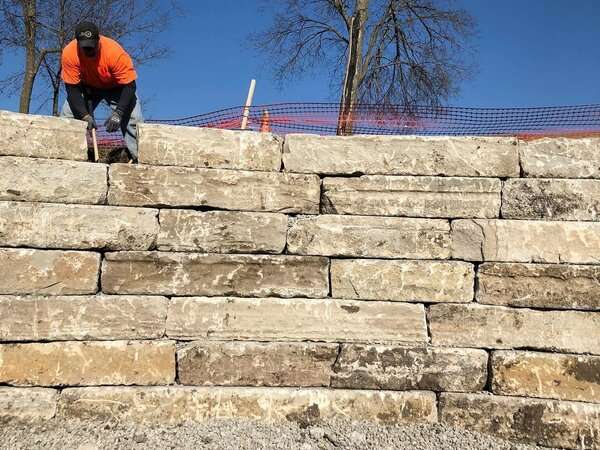
1. Take the wall apart
Taking down the wall is part of how to fix a leaning stone retaining wall because it’s likely the subgrade, also called footing, is failing. This is often what causes the lean. We have to get to it to fix it, which means we have to take down the wall.
2. Note how the stones are put together
The main reason for this is so we can rebuild your wall exactly how it was, well, unless some stones need replacing. But it’ll be close! We’ll have a quicker and easier time rebuilding it. This means you’ll have your wall back quicker and we’ll be out of your hair.
3. Replace any failing stones
This will help your wall last longer and look better.
4. Inspect the subgrade
We want to make sure we find the problem and fix it. It might not just be your problem is some stones that need replacing. Leaning retaining walls often have bad or damaged subgrades. It could be tree roots or animals disturbing the levelness.
5. Take corrective measures
We’ll fix the subgrade so your retaining wall doesn’t lean. This could mean removing tree roots, refilling and compacting the footing, moving stones around, or other fixes.
6. Compact the subgrade
This is to make sure it doesn’t shift and cause further problems.
7. Rebuild like normal

How To Repair A Collapsed Stone Retaining Wall
1. Take the wall down
We have to finish taking it down so we can figure out the extent of the problem. We don’t want to do a half-baked job and cause you more problems down the line.
2. Note how the stones are put together
The main reason for this is so we can rebuild your wall exactly how it was, well, unless some stones need replacing. But it’ll be close! We’ll have a quicker and easier time rebuilding it. This means you’ll have your wall back quicker and we’ll be out of your hair.
3. Replace any stones as needed
Sometimes we find stones that need replacing before they start causing problems.
4. Analyze to see what caused the collapse
We’ll find the problem and come up with a solution.
5. Fix whatever caused the wall to fail
Whether it’s drainage, erosion, bad stones, etc, we’ll fix your wall!
6. Compact the subgrade
This is to keep other problems from popping up after we rebuild your wall.
7. Rebuild Your Stone Retaining Wall

How Long Should A Retaining Wall Last?
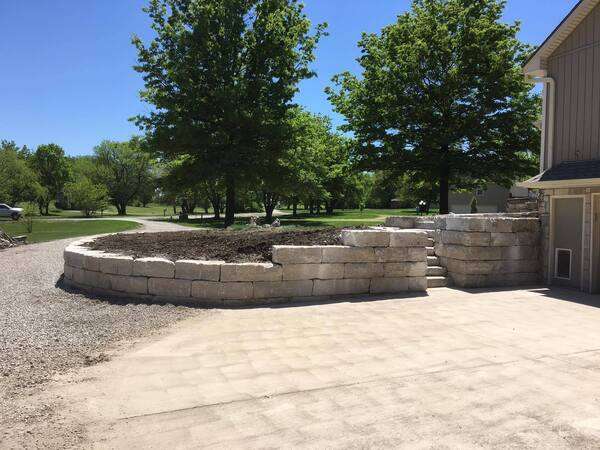
Stone retaining walls should last somewhere between 40 and 100 years or more. Wood retaining walls last around 40 years. Stone and concrete retaining walls last between 50 and 100 years. Brick retaining walls last at least 100 years. It mainly depends on the material, climate, drainage, maintenance amount, design, and unexpected events.
What Mainly Changes How Long Retaining Walls Last

Material. Wood doesn’t last as long as the other materials. It’s more prone to damage from pests, moisture, weather, and everything else really. But, the unique look it provides can make it worthwhile. Using the best material for retaining walls can help it last longer.
Climate. Consistent storms and harsh weather can wear them down more quickly. Easier climates tend to have less of an impact on how long they last.
Drainage. Poor drainage causes harm in multiple ways. It pushes against the wall, makes the soil heavier when pushing against the wall, and it wears away at the stone to make it thinner.
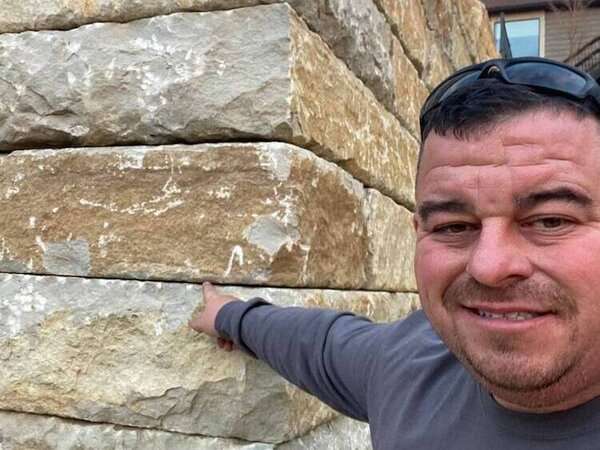
Maintenance amount. Regularly maintained retaining walls tend to last longer, excluding unexpected events. It’s a great way to find out if anything’s going wrong before it causes too much damage.
Design. Poorly designed ones will fail faster. They allow damages to happen more quickly and they can’t support themselves as well.
Unexpected events. Bad weather and soil erosion are great examples of this. Even a car ramming into one by accident can cause enough damage.
Damages. There are several reasons retaining walls fail, and they usually start with damage. The damage can come from soil erosion, improper drainage, age, being hit by something, and more.
You May Also Like To Know
“Well, if it does look offset, maybe we should have someone come check it out,” says Jennifer. Michael nods. “Maybe. Let’s get some more information before we start making calls. We might be able to use this blog for more info.”
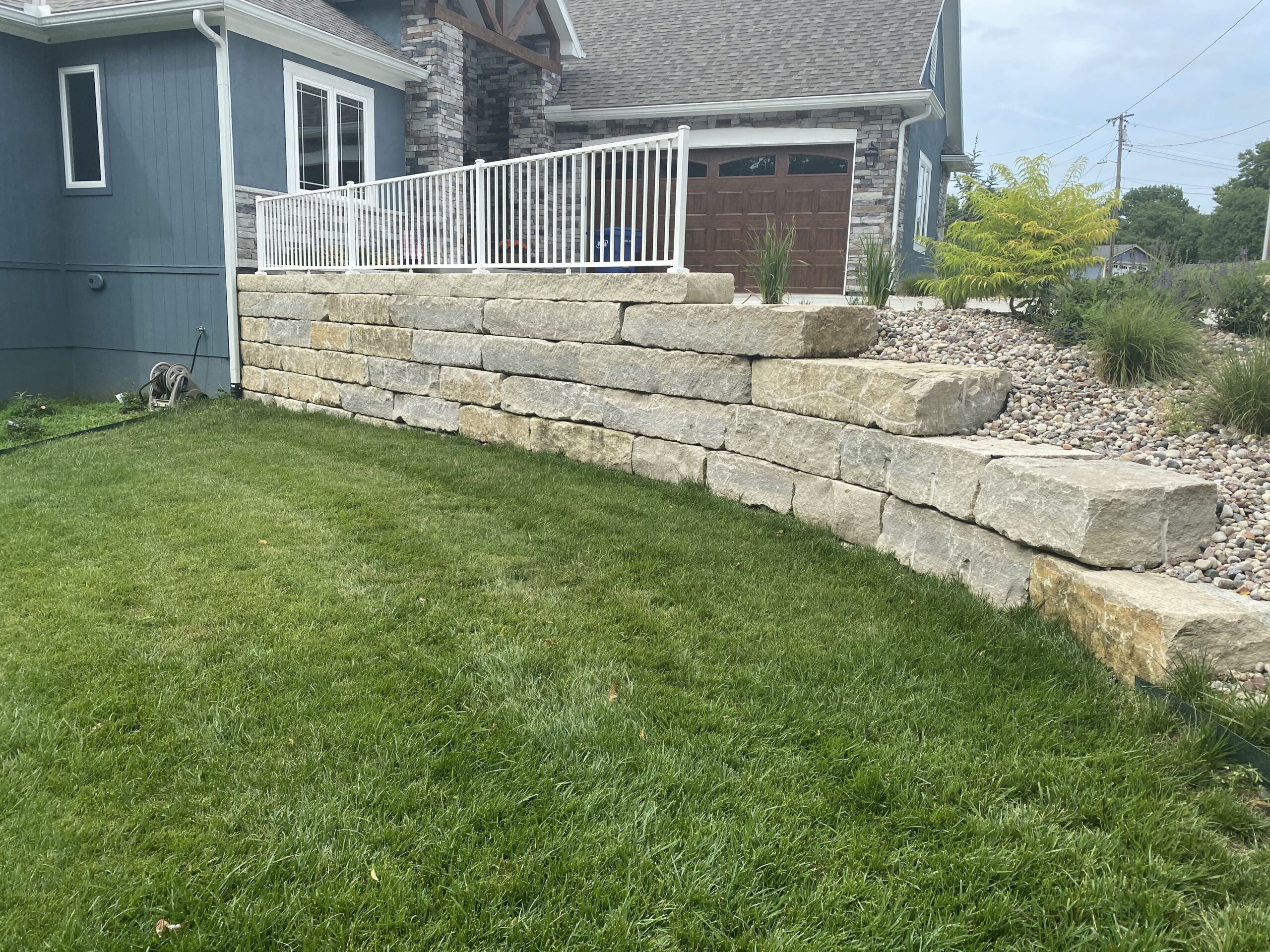
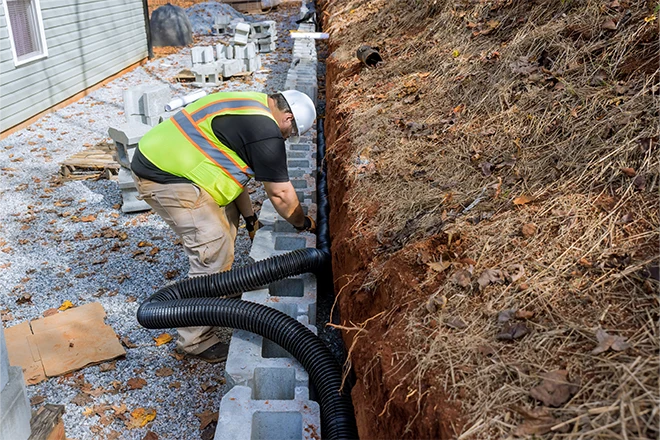


Oh, wow! I never thought that irrigation systems can also influence the strength of a retaining wall too. This makes me think of my uncle who plans to build a barrier so the nearby hill won’t spill any mud during heavy rain. I’ll remind him to hire an expert to make sure the right structure is being set up.
If a solid cement retaining wall at the end of a street has a crack in it, if it fails, will the street go down?